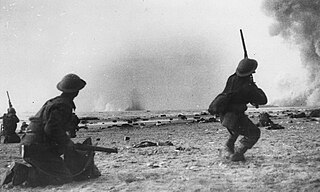
The Battle of Dunkirk was fought around the French port of Dunkirk (Dunkerque) during the Second World War, between the Allies and Nazi Germany. As the Allies were losing the Battle of France on the Western Front, the Battle of Dunkirk was the defence and evacuation of British and other Allied forces to Britain from 26 May to 4 June 1940.

Dunkirk is a commune in the department of Nord in northern France. It lies 10 kilometres (6.2 mi) from the Belgian border. It has the third-largest French harbour. The population of the commune in 2019 was 86,279.

The Distinguished Service Cross (DSC) is a third-level military decoration awarded to officers; and, since 1993, ratings and other ranks of the British Armed Forces, Royal Fleet Auxiliary and the British Merchant Navy have been included. Additionally, the award was formerly awarded to members of other Commonwealth countries.

The Distinguished Service Medal (DSM) was a military decoration awarded until 1993 to personnel of the Royal Navy and members of the other services, and formerly to personnel of other Commonwealth countries, up to and including the rank of Chief Petty Officer, for bravery and resourcefulness on active service at sea.
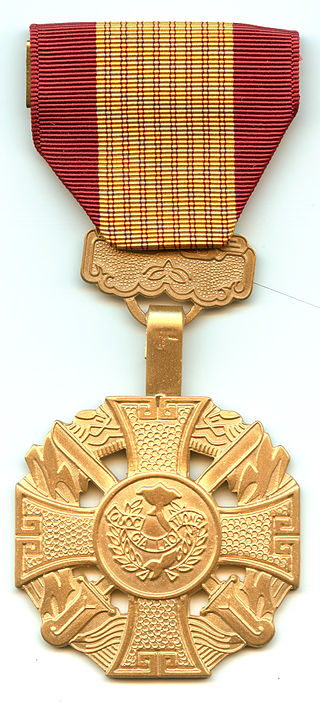
The Republic of Vietnam Gallantry Cross also known as the Vietnamese Gallantry Cross or Vietnam Cross of Gallantry is a military decoration of the former Government of South Vietnam. The medal was created on August 15, 1950, and was awarded to military personnel, civilians, and Armed Forces units and organizations in recognition of deeds of valor or heroic conduct while in combat with the enemy.

The Medal of a liberated France was a decoration of the French Republic created by decree on 12 September 1947 and originally named the "Medal of Gratitude of a Liberated France". It was intended as a reward for French and foreign nationals that had made a notable contribution to the liberation of France from the German occupation.
The World War I Victory Medal was a United States service medal designed by James Earle Fraser of New York City under the direction of the Commission of Fine Arts.
The Army of Occupation Medal is a military award of the United States military which was established by the United States War Department on 5 April 1946. The medal was created in the aftermath of the Second World War to recognize those who had performed occupation service in either Germany, Italy, Austria, Japan or Korea. The original Army of Occupation Medal was intended only for members of the United States Army, but was expanded in 1948 to encompass the United States Air Force shortly after that service's creation. The Navy and Marine equivalent of the Army of Occupation Medal is the Navy Occupation Service Medal, which features the same ribbon with its own medallion and clasps.

The Conspicuous Gallantry Medal (CGM) was, until 1993, a British military decoration for gallantry in action for petty officers and seamen of the Royal Navy, including Warrant Officers and other ranks of the Royal Marines. It was formerly awarded to personnel of other Commonwealth countries. In 1943 a Royal Air Force version was created for conspicuous gallantry in action against the enemy in the air.
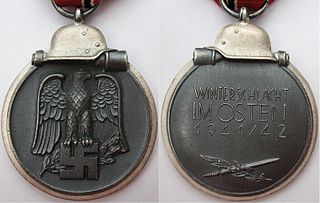
The Eastern Medal, officially the Winter Battle in the East 1941–42 Medal, was a military award of the Wehrmacht which was created by ordinance of Adolf Hitler on 26 May 1942.
The King's Fire Service Medal, introduced in 1954, is awarded to members of the fire services in the United Kingdom for distinguished service or gallantry. It was also formerly awarded by Commonwealth countries, most of which now have their own honours systems.

The Maritime Medal 1940–1945 was a Belgian bravery award of World War II, established by Royal Decree on 17 July 1941 and awarded to members of the Belgian Navy, merchant navy or fishing fleet for acts of heroism in the saving of ships or lives during an action against the enemy.

The Medal for Services Rendered is a Belgian military service medal that was proposed to be created on 18 April 1988 by ministerial decree. It was intended to be awarded to members of the army, navy, air force and medical services of the Belgian Armed Forces for service rendered in particularly difficult circumstances over an extended time period. However, the creation of the medal was presented to the Council of State under the form of a ministerial decree and the Council ruled that the creation of such an award should be done by the King, thus via a Royal Decree. As a Royal Decree was never adopted, the medal was never officially created and has not or cannot be awarded.
The Royal West African Frontier Force Long Service and Good Conduct Medal was established in September 1903 to reward native African NCOs and men who had completed 18 years, later reduced to 16 years of exemplary service in the Royal West African Frontier Force (RWAFF).

The Order of Civic Merit of the Kingdom of Laos was established on November 20, 1950 under Royal Ordinance No. 186 by H.M. Sisavang Phoulivong, The King of Laos. It is an Order of Civic Merit for civil officials and military officers. It was awarded for meritorious and courageous service to the State in three classes. Until 1975 the approval authority was the Prime Minister of the Royal Lao Government. The current approval authority is H.E. Professor Maha Khamphoui Sisavatdy, Prime Minister of the Royal Lao Government in Exile as an elected successor to the Office of the Prime Minister of the Royal Lao Government.

The Ebola Medal for Service in West Africa, known simply as the Ebola Medal, is a service medal for issue to the Armed Forces and to civilians, working either for Her Majesty's Government or for non-governmental organisations, in support of the British Government's response to the Ebola crisis in West Africa between March 2014 and March 2016. The medal is the first to be awarded by the UK Government for a humanitarian crisis response.
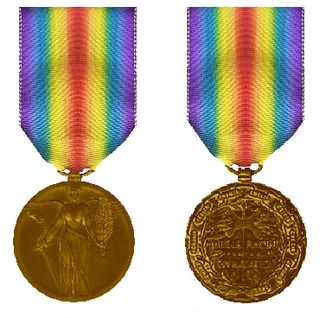
The Victory Medal is a Romanian First World War campaign medal established on 20 July 1921 by Royal Decree.
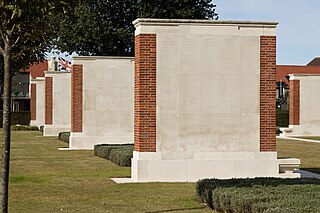
The Dunkirk Memorial is a Commonwealth War Graves Commission memorial to the missing that commemorates 4,505 missing dead of the British Expeditionary Force (BEF), most of whom fell prior to and during the Battle of Dunkirk in 1939 and 1940, in the fall of France during the Second World War.

The Honour medal of railroads is a state decoration bestowed by the French Republic in the form of an honour medal for work. It was originally meant to reward, depending on the quality and length of time calculated in calendar years, the services rendered by French agents and labourers and to nationals of the French Union or protectorates, in service with the railroads. The Honour medal of railroads was created by decree on 19 August 1913 as a reward for thirty years of service. Since then, many modifications were instituted by consecutive decrees amending the original text.

The Political deportation and internment medal is a commemorative medal awarded by the Ministry for veterans and war victims of the French Republic to its citizens who were deported or interned by the German occupation forces during World War II.
















